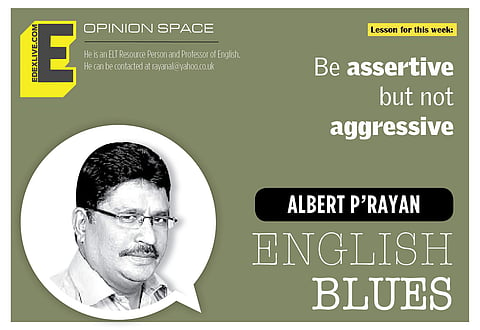

In last week’s column, I discussed the need for learning the art of persuading people using empathetic (empathic) and emotive language. When we use empathetic language, we understand the needs of those with whom we communicate and try to create better connections with them. Our words make them feel that they are cared for and supported. Empathetic communication is based on the principle ‘Treat people the same way you want them to treat you’.
When we persuade someone, we try to help someone change their mind and behaviour. It is done with good intention. There is no hidden agenda. As I had mentioned in my column last week, most people think that the word ‘persuade’ and its derivatives ‘persuasion’ and ‘persuasive’ imply a negative connotation but they are neutral terms. It is the intention of the persuader that makes a difference. A persuader with good intention is assertive and not aggressive. ‘Assertive’ is a positive term whereas ‘aggressive’ is a negative term. Those who are assertive aim at building a rapport with others. They know how to express their opinions and feelings in an appropriate manner and they do respect the views of others and treat them equally. They succeed in winning others. Those who are aggressive put themselves first and do not care about others.
Assertive communicators express their views confidently, courageously, clearly, concisely and convincingly. Remember the 5Cs. They speak their mind in a respectful and powerful way. They do not impose their views on others. Psychologist and Holocaust survivor Edith Eva Eger expresses the difference between being aggressive, assertive and passive in these words: “To be passive is to let others decide for you. To be aggressive is to decide for others. To be assertive is to decide for yourself. And to trust that there is enough, that you are enough.”
Assertive communicators do not put the blame on others. They respect the feelings of others while expressing their feelings and views. They avoid using ‘You’ statements. Here are examples:
1. You never cooperate with others.
2. You have wasted time. You are always like this.
Assertive communicators formulate their sentences in an assertive way. They use ‘I’ statements. Look at these examples:
Instead of saying, “It is your mistake”, “You are wrong” or “It is your fault”, they say: “I beg to disagree with you”, “I don’t agree with you” or “I have a different opinion”.
An effective ‘I’ statement has these four parts: 1) taking responsibility for one’s feelings, 2) stating the problem, 3) stating the consequence, and 4) offering an alternative or compromise. Here is an example:
I feel sad as we didn’t include John in our team. If he had been a part of the team, we would have completed the project in time.
Assertive communicators avoid using phrases such as ‘I guess’, ‘supposed to’ and ‘but’ as they connote weakness. Here are some useful phrases used in assertive communication:
I would appreciate it if…
Let’s get started
Let’s get straight to the point
